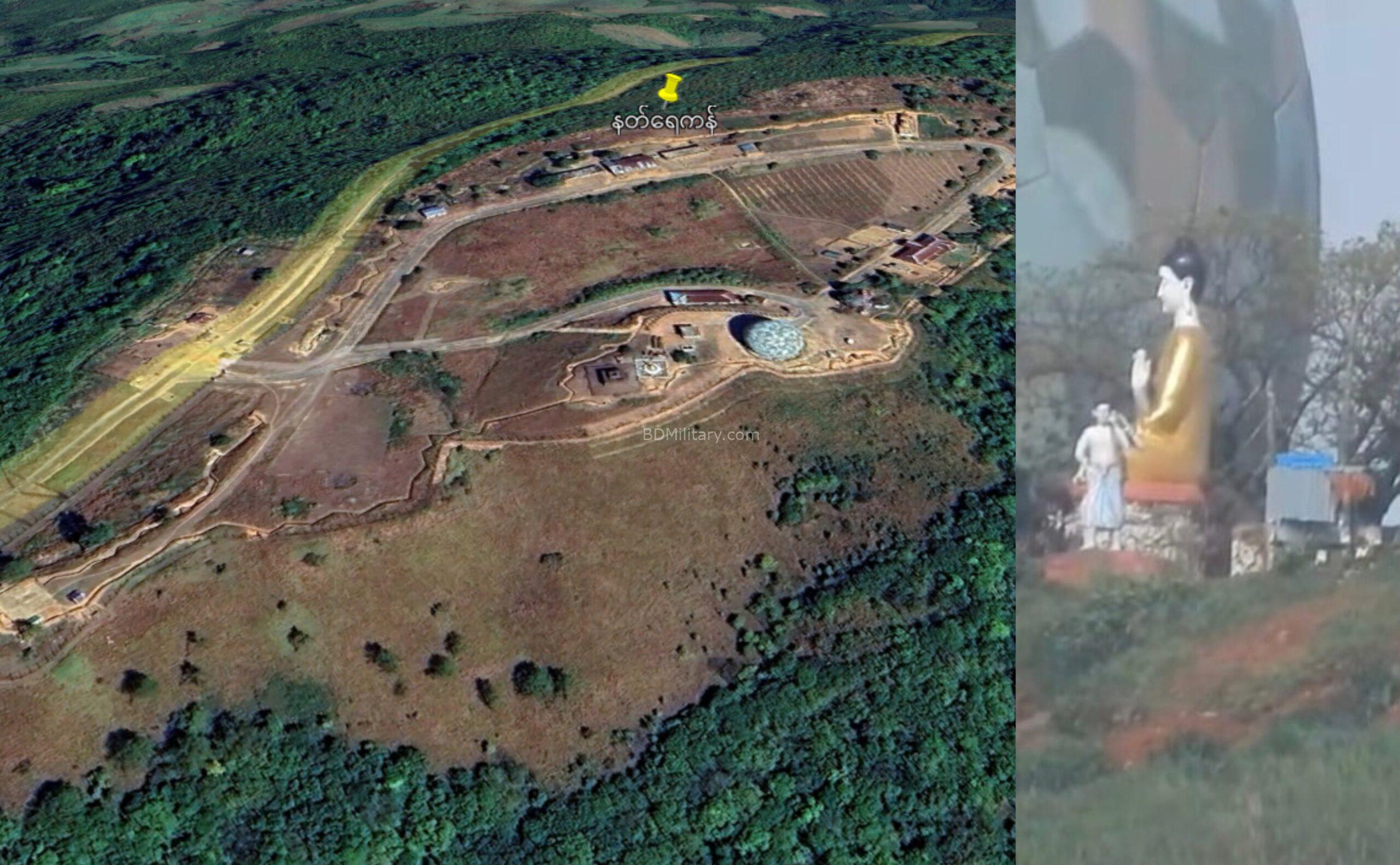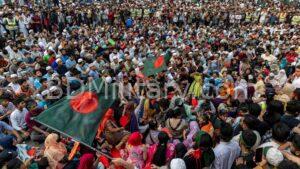The Arakan Army (AA) and its allied resistance forces are on the verge of capturing the Nat Yay Kan Air Defence Base in Ngape Township, Magwe Region, after overrunning nearly all forward outposts defending the hilltop stronghold, according to multiple frontline sources.
Earlier this month, the AA seized the Gokkyi supply post, located just three kilometres north of Nat Yay Kan. The post, defended by around 100 junta troops, had served as a key logistical lifeline providing food, ammunition and reinforcements to the main air defence base. Nat Yay Kan itself sits atop a 1,587-metre mountain roughly 12 kilometres from Ordnance Factory (KaPaSa) No. 14 — one of the Myanmar military’s most important arms-production facilities, with production lines for missile components, electronics (PCB, radar), and general ordnance.
Reports indicate that over 500 junta troops had been stationed at the base, which also serves as a major artillery and radar installation. However, after days of intense fighting, only one hilltop position reportedly remains under junta control. “They haven’t lost the entire base yet, but most of it has fallen. Only one position remains, where troops are entrenched in bunkers under continuous airstrikes,” said a local resistance source quoted by The Irrawaddy.
The junta garrison, now surrounded and cut off for more than ten days, is said to be “starving and low on water.” Despite limited air-dropped resupplies, the position appears untenable. AA units have completely encircled the area, tightening the siege and blocking any ground reinforcements from Padan, located just 16 kilometres away.
Padan is home to Artillery Battalion Headquarters 905, several artillery units, and the KaPaSa 14 munitions plant. The fall of Nat Yay Kan would place these facilities directly within range of AA-led forces. Analysts warn that this would cripple the junta’s ability to project power westward toward Ann and Rakhine State and threaten its network of arms factories along the strategic Pathein-Monywa highway.
Strategic Proximity to Bangladesh
Nat Yay Kan lies approximately 270 kilometres northeast of Cox’s Bazar, placing it within a region of increasing concern for Bangladesh’s defence planners. Should the Arakan Army consolidate its control over Magwe and extend its reach toward central Myanmar, the military balance along the Myanmar–Bangladesh frontier could shift dramatically.
For the Bangladesh Air Force (BAF), the evolving situation has both operational and strategic implications. The weakening of the Myanmar Air Force (MAF) in western Myanmar — particularly its loss of air defence sites such as Nat Yay Kan — could reduce the MAF’s capacity to conduct sustained operations near the Rakhine and Chin border regions. This, in turn, enhances BAF’s operational freedom and surveillance advantage over the Bay of Bengal and the Arakan coastline.
Broader Conflict Dynamics
The AA, which now controls 14 of Rakhine’s 17 townships, has been advancing eastward into central Myanmar in cooperation with local resistance groups. Fighting has already spread into Magwe’s Padan Township, Bago’s Padaung Township, and parts of the Ayeyarwady Region, where several munitions factories lie along the Irrawaddy River’s western bank.
If Nat Yay Kan falls, it will mark one of the most significant strategic defeats for the junta since the fall of Ann in December, when the AA captured the regime’s Western Command headquarters. The loss would effectively break the junta’s last defensive line between Rakhine and central Myanmar — opening the door to deeper resistance penetration toward the country’s industrial heartland.
For Bangladesh, located less than an hour’s flight from the contested zone, developments at Nat Yay Kan warrant close monitoring. The outcome will likely redefine air defence posturing and influence future contingency planning for both the Bangladesh and Myanmar air forces along the western theatre of the Bay of Bengal.
Myanmar Defence Industries (KaPaSa)
| KaPaSa / DI No. | Location (Township / Region) | Reported Product Types | Operational Status (per SAC-M & later analysis) |
|---|---|---|---|
| KaPaSa 1 | Tatkone, Nay Pyi Taw | Administration & small arms production | Active |
| KaPaSa 2 | Myaing, Magway Region | Mortars, RPGs, artillery shells | Active |
| KaPaSa 3 | Sinde, Bago Region | Ammunition, fuses | Active |
| KaPaSa 4 | Tatkone, Nay Pyi Taw | Explosives filling & processing | Active |
| KaPaSa 5 | Kamyaing, Bago Region | Small arms, ammunition components | Active |
| KaPaSa 6 | Nyaung Chidauk, Bago Region | Maintenance, training, small arms assembly | Active (Training role) |
| KaPaSa 7 | Kyaw Swar, Bago Region | Small arms & rifle parts | Active |
| KaPaSa 8 | Ma Kyee Pin Pu, Mandalay Region | Ammunition & components | Active |
| KaPaSa 9 | Okshitpin, Bago Region | Artillery shell filling & assembly | Active |
| KaPaSa 10 | Mya Lan, Magway Region | MLRS rockets, propellant casting | Active; sensitive (missile-related) |
| KaPaSa 11 | Taikkyi, Yangon Region | Storage, logistics, maintenance | Active |
| KaPaSa 12 | Thayet, Magway Region | Ammunition, artillery shells | Active |
| KaPaSa 13 | Let Pan, Magway Region | Ammunition assembly & fuses | Active |
| KaPaSa 14 | Ngape / Padan, Magway Region | Missile components, electronics (PCB, radar), general ordnance | Active; high-value site |
| KaPaSa 15 | Meiktila, Mandalay Region | Vehicle & armour components | Active |
| KaPaSa 16 | Ma Thon, Mandalay Region | Ammunition | Active |
| KaPaSa 17 | Unknown (Central Myanmar) | Propellants / explosives | Possibly limited activity |
| KaPaSa 18 | Central Myanmar (unspecified) | Chemical materials | Unclear |
| KaPaSa 19 | Pyin Ma Ai, Bago Region | Ammunition & shell production | Active |
| KaPaSa 20 | Ngape, Magway Region | Ammunition & artillery | Active |
| KaPaSa 21 | Seikphyu, Magway Region | Aerial bombs, general munitions | Active |
| KaPaSa 22 | Magway (valley site) | Small arms, propellants | Active |
| KaPaSa 23 | Lin Taung, Magway Region | Explosives chemicals | Under construction (2023) |
| KaPaSa 24 | Kanthet, Magway Region | Component production | Under construction |
| KaPaSa 25 | Laungshae, Magway Region | Resource extraction / raw materials | Under construction |
Notes
- The Magway cluster (KaPaSa 2, 10, 12–14, 20–25) forms the core of Myanmar’s heavy ordnance industry, supplying artillery, aerial bombs, and rockets.
- Bago Region hosts several small-arms and training factories (KaPaSa 3–7, 9, 19), supporting ammunition production.
- Nay Pyi Taw (KaPaSa 1, 4) functions as the administrative and assembly hub.
- Yangon / Taikkyi (KaPaSa 11) manages logistics and long-term storage.
- KaPaSa 10, 14, and 22 are identified by SAC-M and Western intelligence analysts as the most technologically sensitive, housing solid-propellant and electronics production.
- As of 2023, 22 out of 25 factories are confirmed operational; 3 remain under construction or expansion.

Khaled Ahmed is a seasoned former intelligence analyst and military expert from the Netherlands, bringing over 15 years of specialised experience in operational intelligence, threat analysis, and strategic defence planning. Having served in high-level, classified roles within Dutch military intelligence, he possesses rare expertise in European security architecture, NATO doctrine, and asymmetric warfare. Khaled’s deep operational insight and international perspective enable him to deliver precision-driven intelligence analysis and forward-looking strategic forecasts. A trusted contributor to high-level risk assessments and security briefings, he offers readers clarity on complex defence and security challenges. Khaled leads the National Security and Fact Analysis sections at BDMilitary. He holds a Master’s degree in International Relations from the University of Groningen, The Netherlands, and is fluent in Dutch, French, and Arabic — combining linguistic dexterity with operational expertise to analyse security issues across cultures and regions.



